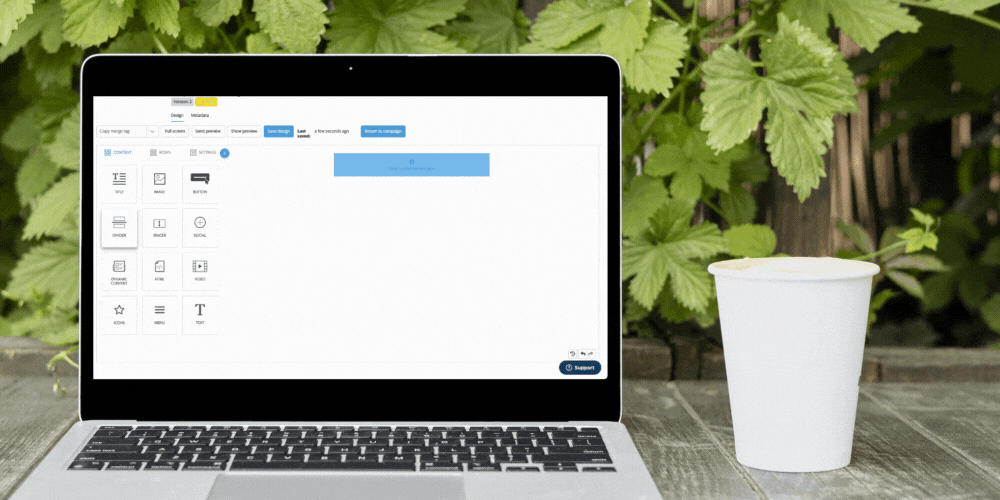
Nonprofit email marketing: A complete guide
The average person checks their email 15 times every day. And though this may not be the best choice for their mental health, it at least means you know where to find them: in the inbox.
With over 4 billion people using email today, it’s almost certain your nonprofit can effectively engage its entire community on the channel.
And not only is email marketing a great way to cultivate a community, it’s also uniquely effective in generating revenue. In 2022, nonprofit email marketing was responsible for 14% of all online revenue.
As if these weren’t good enough reasons, we’ll talk through a few more reasons why email is so essential for nonprofits. Then, we’ll talk through the before, during, and after of building effective emails. And we’ll wrap it all up by clicking that so-hard-to-click send.
Why nonprofit email marketing?
Email certainly isn’t the newest, shiniest of marketing channels.
Though there’s some wrangling about terms, most agree that the first email was sent in 1971 from Ray Tomlinson to Ray Tomlinson. And although it’s gone through some upgrades since, the idea hasn’t changed much.
But this doesn’t make it any less effective. If anything, it’s just proof that the channel has staying power.
Taylor Shanklin, founder and CEO of Barlele, a nonprofit consulting agency, said: “A lot of times what happens in marketing is that there are so many bright, shiny objects. Some are great. Some are a flash in the pan. And you don’t always know what’s going to be what when it’s new. Nonprofits need to keep doing the basics really well and keep doing the channels that they know are working well.”
Nonprofit email marketing is one of those things that isn’t going anywhere!
In our recently released State of Nonprofit Marketing report, we asked over 400 marketers, leaders, and experts in the nonprofit space about their challenges, priorities, and plans for 2024, and we gathered a few illuminating statistics.
One thing that jumped out was the importance of email marketing in the sector. 83% of respondents put email in their top five channels — second was organic social with 71%, followed by peer-to-peer at 33%. We knew email was important, but we didn't realize both it and organic social, more specifically, Facebook/Instagram, would be so far ahead of the pack!
Not all media’s the same
One of email’s great strengths is that it’s a form of owned media. You may have to pay for delivery or for the platform to automate the emails, but you own your list of contacts. They’re your people, so nobody stands in between you and your audience.
Marketing should effectively leverage all forms of media, including paid, owned, and earned. Here are the differences between the three:
- Paid media: This is rented space. Think of Facebook or a Google Ad. You’re on someone else’s platform, speaking to their audience. This has become more and more true of social platforms, especially where even if they’re your followers, your post won’t reach a majority of them unless you "boost" it.
- Owned media: This is all yours. Think about this as if it’s your own house. Think of your website or your emails as owned because when someone lands on your website or reads one of your emails, they’re basically being hosted on your property.
- Earned media: This is just as good as owned media. This is someone giving directions to your property. Think of a link to your blog post or a social post. Someone thought your content was cool enough to recommend it. This is like word of mouth, just online. And the value is that if someone clicks that link, they end up at your doorstep. The key difference — and this is huge — between paid and earned is that earned media was bought with the value of your content. You didn’t have to convince someone to distribute it for you with cash.
Understanding where you want to take your audience is key in finding the right mix between these three. If you’re working on building your email list, then paid media may be a necessity while you work on expanding.
M+R Benchmarks found a link between email list growth and advertising. They say, “Some things are just meant to go together. Peanut butter and jelly. Fish and chips. Cheese and literally anything else. Email and digital advertising.” One of the best ways to build owned channels is with the strategic paid campaign.
Partnerships tend to fill a space in between earned and paid, but if your organization is benefiting from the connection in people’s minds, then we consider it more on the earned side. Yes, cash may be exchanged, but the partnership was ultimately built on mutual trust and respect.
Having a healthy mix of all three is the long-term goal. You want to reach entirely new audiences through geofencing or search campaigns. You want to have partners or influencers sharing your content because it’s awesome. But then you also want to have a really great website where people want to spend time to learn what you’re all about and how they can be a part of the story.
Before you build the email
Templating the process
There are some recipes where it’s best to start with only the base ingredients, but a lot of the time using some canned goods or a frozen pie crust will save you enough time to justify the taste difference.
And this is doubly true for email. Because once you’ve done something right, keeping that consistent brand flavor in the email is actually an added benefit and not a loss.
We recommend working with your designers to create a few templates that you can go back to again and again to save the time of starting from scratch. This way you keep your branding consistent and you save time. That’s the definition of a win-win situation!
One note about templates, though: just because a template worked once doesn’t mean that it’s worth sticking with forever. Consistently testing templates and ideas will give you a better and better working knowledge of your community.
Some audiences actually respond better to less branded and designed emails while others like seeing your colors and imagery. Trying new things never hurt anybody, so even if you do have a great template, every once in a while, try something off the beaten path.
Looking for automated email templates to use?
We've got you covered! We know one of the hardest parts of any work is going from 0 to 1 so we built these templates to help you jump into the wonderful world of automated emails.
First-party data eats best practices for lunch
Instead of launching a campaign based on what someone else said, start with your CRM or inside your email service provider (ESP). You know way more than some consultant about your community, so start with what you already have in hand.
Your CRM or ESP should have a lot of key data points about your audience. Some of the first things you might look into are:
- Relationship: Are they current members? Volunteers? Lapsed donors? What’s their formal connection to your organization?
- Intent: Have they donated in the past? Have they attended the same event every year and nothing more?
- Location: Where do they live and work? Are they a short drive or a six-hour flight away from your next event?
- Source: How did they originally find you? Did they write their email on a physical list when they met you at an event? Did they sign up online to get your recent report? Did they hear about you on Instagram?
- Interest: This is a cross between source and intent. Were they drawn into your organization through your advocacy work? Do they earmark donations to a specific program your team organizes? You may not know exactly why someone supports your organization, but trying to get to the heart of it will help you as you reach out.
In our Good Marketing Framework, we consider these data points to all fall under context and intent. Every relationship that we form with another person includes some amount of information, and we don’t get this information unless we’re listening.
Are you truly friends with someone if you don’t care when their birthday is or if you aren’t aware they’re going through a tough time?
By forming real, lasting connections with your community through effective marketing, you’re building the trust to together push your organization and cause forward.
Defining objectives
Nobody ever got in a car and accidentally arrived at the right destination. It took planning, and a set of directions. And that’s why it’s so important to start with the end in sight — and to ask the right questions at the start:
Is the goal of the email to inform, delight, or activate? Do you need more donors or volunteers? What results are we expecting?
Goals spring from an understanding of your market, audience, or community. Marketing is first about a market, or a community. Understanding those people has to come before cultivating and activating them.
Thinking about a goal as an action that you want your community to take helps connect the goal with the people that you serve and communicate to. Instead of working backwards from a revenue goal, spend time identifying who your organization has meaningful relationships with, and then plan out the right next step for these different segments.
Not all marketing should have revenue as a direct goal. Over the long run, committed, loyal supporters are going to have an impact on revenue. But attempting to get a donation or a membership during a first-time interaction might just turn someone off of the whole idea.
To risk being repetitive, goals have to spring from the relationships that you have. For lapsed donors, getting them back on board might not require as much energy as finding someone who’s never partnered with you before. These are just a few ideas for goals that you can have for your upcoming marketing campaigns:
- Increase newsletter subscribers.
- Build your email list.
- Increase website traffic.
- Boost donations.
- Sign up new members.
Everyone is at a different place in their journey, and that’s true about their relationship with your organization too. The dating analogy may be overused, but it’s helpful here. Proposing on a second date for most relationships won’t go well. Asking the right questions at the right time is a lot of what effective marketing is about. And no one asked a good question without truly listening.
Think of data as the way that your community is talking to you. They likely tell you what type of communications they prefer through their own behaviors. Tracking that and allowing it to inform your campaigns is going to have a huge impact on your results.
A fork in the road
Now that you have a better idea what you’re expecting from your email based on who you’re sending it to, it’s time to decide what type of email you want to send.
You can set up your email just like that first one in 1971, except to more people than just Ray Tomlinson. Or, you now have the option of creating automated emails that send emails depending on a person’s prior actions, such as a nonprofit email drip campaign.
Say someone landed on the registration page for your upcoming event or they made it all the way to the donation page but failed to give. Both of these people could receive a follow-up email based on the triggering event.
Using triggers to determine the when, who, and what of your email can have a huge impact on a campaign’s results. Like we said above, the more connected an email is to the person who’s receiving it, and the more it’s based on their individual context and intent, the more impact it’ll make.
Making a list, checking it twice
An email is only as good as its list of recipients. If they’re nice, and your message was built with them in mind, you should expect nice results. If they’re naughty, no amount of convincing is going to get them to budge.
Your list matters because this is the key to keeping unsubscribes, spam complaints, and costs down. It’s also one of the easiest fixes for boosting deliverability and open rates.
Email lists should be actively cleaned at least once a year, and if you’re getting big numbers coming in each month, one big spring cleaning may just not be enough. Adding a solid audit of your email lists into the yearly workflow is key for keeping the email efforts moving in the right direction.
Hubspot has a great how-to guide for cleaning your email lists, but the essentials are to identify your inactive subscribers and separate them from the rest of the group. Try a few more times to draw this group back into the fold, but if that doesn’t work, it may be best to leave them alone for a moment.
While you build the email
Hubspot also has a great guide for designing highly effective emails, and the classic marketing texts about copywriting can help anyone as they start putting words down. But because every audience is different, there’s no one-size-fits-all strategy for either design or copy.
There is a path forward, however, for finding what works (and what doesn’t) for your audience: listening, testing, and measuring.
Listening includes a lot of different activities, including interviews with your community members and surveys of current or prospective supporters, donors, or members. It can also include more general research within your market. 
We mentioned the Good Marketing Framework already, but it’s essential that an email is written with the receiver in mind. It shouldn’t start simply from an organizational goal — there’s a person on the other side of the send!
We’re going to jump into testing in more detail now, and we’ll talk more about measurement during the section on after sending the email.
Testing, testing, testing
Brady Josephson is the VP of marketing & growth at charity: water. He joined the Feathr team during our first Good Marketing Unplugged session. And one of the key takeaways was the need for testing.
He believes tests should fall into one of three categories: tries, pilots, and experiments.
- Trying is the simplest form of a test. You are really throwing something against the wall and seeing if it sticks. You should still measure the results, but it’s ok if the idea is just the best guess that you have for the problem.
- Pilots are similar to a try, but they have a specified duration. You’re trying something new for a set period of time, and you have set expectations on what would make it a success and what would be deemed a failure.
- Experiments are the most scientific and exacting of all three. You set up a test group and a control group and you ask a specific question with a specified hypothesis. Even if you find many of these experiments to be inconclusive, over time that will help you ask better and better questions about your marketing campaigns.
The best nonprofit marketers aren’t afraid of making mistakes. Swinging for the fences is going to result in a couple of embarrassing whiffs. But with testing, you can prepare yourself for failure and know that it’s a part of the learning curve. And if you take more risks than the rest, you’ll end up way out ahead of the pack.
No marketer got very far without clicking send on that email to 10,000 or clicking publish on that social post or blog article. Taking risks is what it’s all about. Just make sure that you’re taking risks that you can learn from. Measuring every single send or publish will help you line things up for future success.
Every email tells a story
One of the key ingredients to an email's success is the power of the story that’s shared. Email is unique in its flexibility as a format. You likely receive one- sentence emails from coworkers or friends, but you’ve probably also read a long newsletter the same day.
Julia Campbell, host of the podcast Nonprofit Nation, recently spoke of the power of storytelling and equated stories with gold: “Stories raise more money, raise more awareness, more reach and engagement than any other form of content.”
Nonprofits and associations know how important email marketing is to their growth. And without the same cost limitations as other advertising and marketing channels, email will remain an important channel for cost-effective, direct communication.
The design and copy basics
Ok, we do have a few guiding principles for design and copy. But all of them circle around the same idea: clarity. Making your brand memorable through consistency and simplicity are going to make it easy for your supporters to remember your story and get onboard.
For graphic design, KISS is a great acronym. It stands for “keep it simple, stupid,” and the original phrase comes from Navy design methods so that repairs were easy for engineers.
And copy isn’t all that different. Keeping it simple, clear, and brief is going to increase engagement. Year after year, the average time a reader spends in an email has gone down. Litmus estimates that in 2022, readers spent 8.97 seconds with an email. That’s down from 11.8 seconds in 2020 and that’s down from 13.4 seconds in 2018.
It feels like in a decade we’ll all be spending a single second on each email!
Don’t risk losing your audience with complex, convoluted imagery and references. Keeping it simple makes it clear what you’re saying and what you can achieve together.
After you send the email
One of the biggest mistakes is to think that a campaign ends when you click send. This is truly just the start. As all relationships are about communication, it’s now time to switch back into listening mode.
Hopefully, listening was the start of the process. You began following engaged segments and noticing trends for what their interests were. Now you’re listening to how they respond to your email.

This will inform how you take the next step with this group. If engagement rates weren’t great, or even if they were great, it’s time to start optimizing for the next time. Peter Drucker, often considered the founder of modern management, said, “what gets measured, gets managed.”
If you don’t measure your marketing campaigns, there’s no telling what direction they’ll go in the future. Measurement is both the last step and the first step in the Good Marketing Framework since you now understand your audience better than when you first launched the campaign.
Amanda Garzon, COO for the Hydrocephalus Association, joined the Feathr team for a Good Marketing Unplugged session. She didn’t originally come from a marketing background, but she understood one of the key principles to marketing success.
She said, “To be a marketer, you have to be ok with being wrong, or failing. Because so much of what you do misses. And then you learn from all of those things.”
Not every failure is the same, however. Creating scenarios where you can learn the most from every swing is key. And that’s where trying, piloting, and experimenting come in.
Clicking send
We know how hard it is to click send. It doesn’t matter if it’s just to Ray Tomlinson or to 10,000 people, we know you put care behind every email because you’re all in with your cause and community, and because of that, each email really matters.
But don’t let that care get in the way of putting yourself out there. One of the other great takeaways from Brady Josephson’s interview was his marketing axiom: “It’s just rock n’ roll.” He said he got this quote from Bruce Springsteen, who thinks having fun and taking risks is a part of the serious work of being a rockstar.
Yes, what you do is life-changing and requires a level of seriousness and commitment. But it’s also exciting, risky, and fun. So get out there and click send!
You May Also Like
These Related Stories

Nonprofit email automation: 3 ways to take email further

How to re-engage lapsed donors with email mapping campaigns
